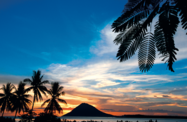Indonesia plans to promote its natural and cultural attractions in order to reach its target of 7.6m tourist arrivals in 2011, with an emphasis on “eco-cultural” sights and activities. These are expected to attract well-heeled visitors who spend more and have less of an impact on the environment.
In December, Esthy Reko Astuty, director of promotions at the Culture and Tourism Ministry, announced that Indonesia’s eco-cultural strategy for 2011 would see environmental issues such as climate change featured in promotional activities as well as a programme launched to encourage more visits to museums.
The strategy is likely aimed at attracting eco-related, adventure and cultural tourists, rather than resort vacationers, as the former help to generate higher profit margins while their activities have a lower environmental impact. Esthy said that tourism ventures that are eco-friendly and involve Indonesian culture would benefit, for example, tour operators offering trekking, jungle trips, and visits to historic sites. Local tourism operators often tend to follow the national promotional strategy when coordinating their work with foreign agencies.
The 2011 strategy is designed to help shift Indonesia’s tourism sector up a gear as it reaches an important stage in its evolution. Tourism volumes have been encouraging in 2010, and the outlook for growth is strong. But in an increasingly competitive regional market and with substantial parts of the country still under-visited, Indonesia is not willing to rest on its laurels.
Foreign tourist arrivals are expected to show a remarkable 18.5% rise to 7.56m for full year 2010, according to a recent report by Business Monitor International. The government also increased its forecast for arrivals from Europe for the year from 700,000 to 1m, after an impressive first half, and with flights between Amsterdam and Jakarta by Indonesian flag carrier Garuda having recommenced in June. All Indonesian airlines were barred from EU airports in 2007 over safety concerns, but the ban has now been lifted. Garuda chose to re-launch flights to Amsterdam due to the strong cultural and historical links between Indonesia and the Netherlands. Meanwhile, tourist numbers from populous and increasingly affluent China and India are expected to rise at a steady clip for the foreseeable future.
Indonesia’s neighbours are also building up their tourism capacity and long-haul transport connectivity. Thailand has long been a tourism hot spot in the region, attracting beach and island hoppers and trekkers. Malaysia, meanwhile, has been successfully promoting itself under the catchy slogan “Malaysia Truly Asia”. Vietnam and Cambodia are very much on the regional tourist map and Laos, a closed country two decades ago and still plagued by poor infrastructure, is an emerging destination.
It is with both rising global demand and competition in mind, then that Indonesia is upping its promotional efforts and developing less well-known destinations. While Bali will continue to draw in visitors from across the world, Esthy also drew attention to Komodo National Park in West Nusa Tenggara, which has been shortlisted as a finalist for the “New Seven Wonders of Nature”, a multinational competition to find Earth’s seven greatest natural wonders. Komodo, which is most famous for its “Komodo Dragons”, the world’s largest lizards, attracted 40,000 tourists this year, according to international press reports. Significant growth in visitor interest is expected, but, in line with the country’s eco-friendly tourism strategy, development will be carefully planned and regulated to prevent damage to the environment.
The national park is one of seven places in Indonesia inscribed on the list of UNESCO World Heritage Sites, identifying its global importance and affording it special protection. Others include the eighth- and ninth-century temple compounds at Borobudur, a number of tropical rainforests in Sumatra and the mountainous Lorentz National Park in Papua.
The Indonesian government is now seeking the inclusion of Mount Batur National Park in Bali and Pacitan, in East Java, in UNESCO’s growing Geoparks Network. The network seeks to enhance “the value of such sites while at the same time creating employment and promoting regional economic development”, according to the organisation. Mount Batur is an active volcano in north east Bali, surrounded by two caldera (basins formed by volcanic action), while Pacitan is famed for its coastal caves and its section of the Thousand Peaks mountain range. UNESCO recognition of the areas is likely to help both conservation and tourism development, while increasing recognition worldwide.
After a strong year in 2010, Indonesia has laid out a strategy that could take its tourism industry to the next level.

